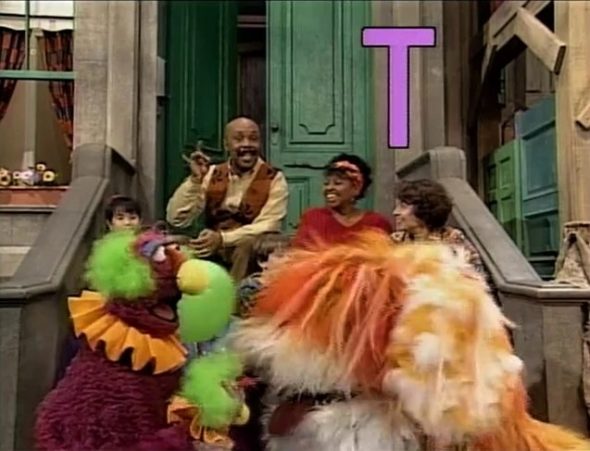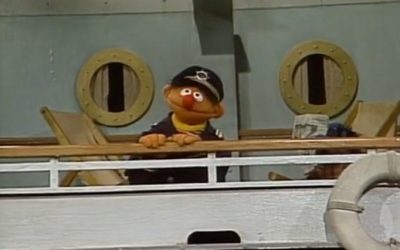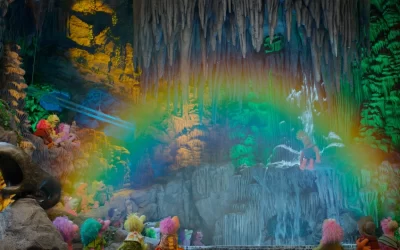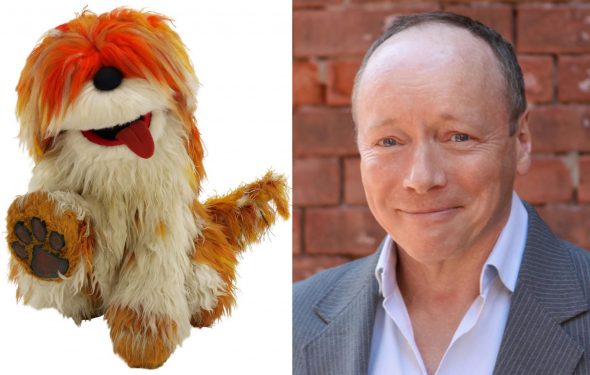
R. Bruce Connelly is an accomplished stage actor and author — and sometimes, he’s a dog. Since 1993, Connelly has been the performer of Sesame Street‘s large and lovable canine, Barkley. He’s also worked on a number of other interesting Muppet and Henson projects over the years.
Mr. Connelly has some great memories and insights, and he shared so many of them with us that this will be a three-part article! In this first installment, Connelly talks about auditioning to be a Muppet dog, the logistics of the Barkley puppet, Barkley’s understanding of sign language, and a close encounter with a hungry mastiff. (This interview has been edited for clarity.)
Tough Pigs: I guess the obvious place to start is: How did you end up working on Sesame Street? What led you to it?
R. Bruce Connelly: Michelan [Sisti] and I had worked together in a pantomime company called Orkidstra, which was comic stories set to classical music. We would play with symphony orchestras all around the country. And he got involved in Dinosaurs. He played Charlene, the daughter, and he also played – I forget the guy’s name. He kind of looked like a turtle standing up. He was a tree-pusher with Earl.
TP: One of the co-workers.
RBC: Right, one of the ones destroying the environment. [laughs] He’s a brilliant pantomime artist, and he was offered the role of Barkley out in California, but he wanted to stay out there, so he recommended me. That’s how I even got the audition. They would not have known about me at all were it not for Miche.
So the audition – it was funny, I flew out to Montana, I was taking a vacation, and I was going to go camping in a teepee. I just checked my messages, and the audition was two days later. I had to get back to New York. I called them and said, “Is there any other day but Friday?” and they said, “No, no, it’s only Friday.” I wasn’t going to be a problem, so I got on a plane and came back.
And I’d never seen Barkley! I’d never seen him on the show!
TP: Were you familiar with Sesame Street? You just hadn’t seen the character before?
RBC: Yeah. The funny thing is, I used to live next door to Sesame Street. They used to tape on 81st Street at Reeves Teletape. You know, you see somebody two or three times in New York, you think you know them, and there was a doorman at Reeves Teletape named John. One day, he told me what was filming there, and I had no idea that Sesame Street was next door!
He said, “Do you want to come in and watch?” And I stood up there on the balcony and he showed me Snuffy hanging from the ceiling, and Caroll [Spinney] was walking around with his Big Bird legs on. It was very cool!
Of course, in college we discovered Sesame Street. One day someone turned the TV on and it was Grover doing “Near and Far” and we were hooked. It was the funniest thing I’d ever seen. It was just so funny, and we all in college got into it at the same time.
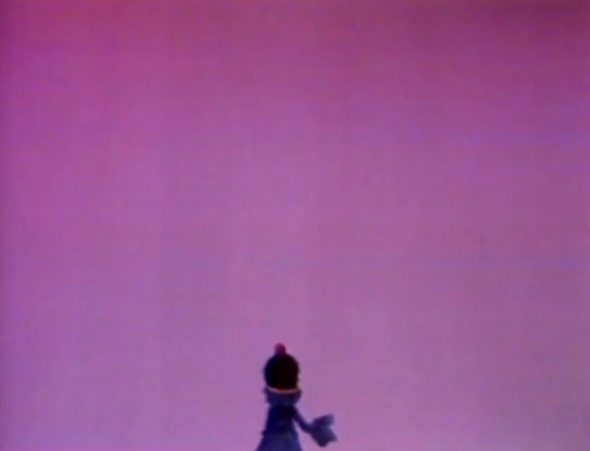
TP: That’s interesting, how in those early years it does seem like people of any age would just turn on the TV to watch the show because it was so entertaining.
RBC: Oh yeah. We wanted to see Grover. Do you know the song “Lulu’s Back in Town?”
TP: Yes! That’s one of those clips that’s sort of resurfaced on YouTube.
RBC: [laughing] That little, meek man singing his little song, and all of a sudden this gigantic monster with earrings comes out and starts throwing him all around! Every day, we would watch to catch the Muppets on that. In college, we already knew our alphabet by then, but we watched for the comedy.
TP: I’m not sure what the educational value of “Lulu’s Back in Town” is, but it’s very funny.
RBC: Yeah, I wondered too. I saw it again recently and I thought, “Okay, what are they teaching here?” I think maybe it’s size. Big and small? Quiet and loud? All the Muppets just running away.
Now you’re making me think of all these sketches – peanut butter stuck to the roof of [Grover’s] mouth. There were routines they did that we just picked up and did forever. It was so much fun. I was very aware of them beforehand.
And Sonia [Manzano] and I worked in Godspell. She was in the original company of Godspell, and then about three or four years after it had begun, I got into Godspell and traveled around in it, and eventually Sonia and I did Godspell together.
TP: The day when you got to visit the set, how long was that before your audition? Was that a few years…?
RBC: Oh yeah, years. I was traveling around doing theater… maybe 20 years? They moved [production of Sesame Street] from my neighborhood over to the CBS building on 57th at one point. But it was very cool. If someone said, “Can you tell me how to get to Sesame Street?” I could say, “Yeah. It’s right there. Across the street.”
TP: So then you went in to audition.
RBC: Right, I came back and they had sent a tape [of Barkley] to my house so I could watch it, and I saw this dog running through Central Park and catching a frisbee in his mouth, and I had no idea how it worked. I couldn’t figure that out. It can’t be two people in there running like that. I had no clue; it was just amazing.
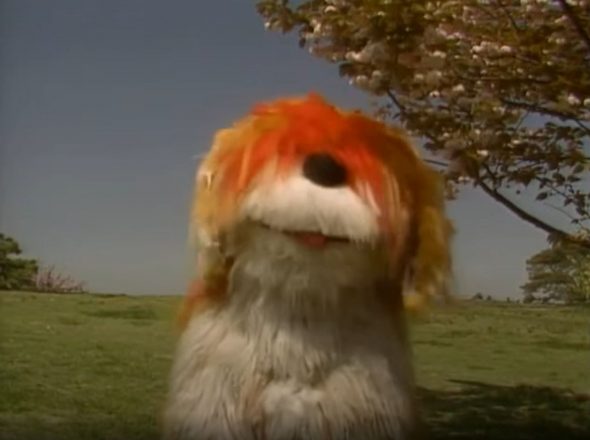
I went in the next day, and I prepared something, thinking: Sesame Street is a lot of problem-solving and cooperation and all that. I thought I could work up a routine where I’m playing with a ball and I hit it under the table, and I come up with three different ways to get it out from under the table.
I’d try to reach for it, and I’d crawl under the table and hit it out – but then I’d be too big to get out, so I’d do one of those Muppet sighs to the camera. “Sheesh!” That’ll show some Muppet humor.
I walked into the room over at [the Henson Associates carriage house]. It was upstairs there, and there was a guy standing up in a suit when I came in, and then another man put the suit on, and he looked just exactly like a dog running all around. I’m thinking, What do I do that’s different?
TP: So they actually had you put on the Barkley suit for the audition?
RBC: Yes. Right. The thing I noticed was, when I put it on, the tongue was firmly pressed over my nose and mouth. There was no oxygen coming in.
TP: Wow!
RBC: Right! I didn’t want to complain, but I thought, If this is the way the suit fits, you have to work with that. During the callback I asked if the tongue was moveable, and they said, “Yes” and unpinned it. You could request a tongue move! But I didn’t know. I figured you work with what they’re giving you. I put the costume on and I only had the air that I went in with. I could not get air through the costume. And I couldn’t see!
They didn’t have a ball, so they gave me a wig block. So this head was lying there on the floor. I hit it like a golf club. It wasn’t at all like a dog would move. I couldn’t see it, so I just swung my leg finally and hit it. And I couldn’t breathe.
As it turned out, I hit it exactly under the far corner of the table that I was working with. That was just purely by accident. Then I did a “Woof!”, expelling any other oxygen that was in my lungs, and tried to reach, and then – [gasping] I have no more air – I swing my leg, unable to see the wig block, hit it, and out it goes from under the table. And then, that exhalation I was talking about at the end? I didn’t have air to exhalate! I just sort of raised my shoulders and dropped them.
And then… pause… and I heard somebody walking toward me, saying, “Well, I bet you’d like to get out of the costume.” I said, “Yes, hurry, please.” I didn’t want to panic, but they opened the chest and uncovered my nose, and I was able to breathe and that was that.
We did a couple of other things, and then about two months later they had me come back and work with Brian Muehl, who had done Barkley for Big Bird Goes to China and Big Bird Goes to Japan.
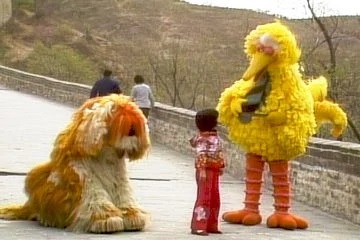
TP: He had done Barkley before, and Fred Garbo was right before you, right?
RBC: Right. Brian was from about 1980, and there was somebody else who began Barkley… From the lore I’ve heard, Barkley was an acrobat initially. They had him doing fantastic, un-doglike, energetic movement.
TP: Okay, that would have been Toby Towson, who’s credited on Muppet Wiki for just one year, in 1978.
RBC: Okay, so then Brian took over. Jim Henson decided to make him a real dog as opposed to an acrobat.
TP: That’s interesting, because that is the way people think about Barkley. He just seems like a real dog.
RBC: Right, and that’s actually how I got the callback. They said “We can teach you how to use the costume better, but we can’t teach someone how to understand dogs. “
TP: Do you consider yourself a dog person?
RBC: Oh yeah. When I was a kid – this is weird, because it all worked out – I wanted to be The Shaggy Dog. When that movie came out, I loved that whole idea and I wanted to be able to turn into a shaggy dog. [laughs] So, lo and behold–!
TP: That’s a very specific dream to have come true!
RBC: Isn’t it? I didn’t want to be an astronaut. I wanted to be a sheepdog. [laughs]
I worked with Brian for two or three days, and he was so good. He’s just wonderful. We did some improv stuff and he would give me an idea of what’s going on in a scene, and he would have me play around in the costume and see what I could do. He reminded me that Barkley is like a three-year-old puppy. After all these years, he still is; he’s a big puppy. He said in my audition I looked like a dog coming home after a very long day. [laughs]
He showed me how to run on these crutches, and that’s a thing. It’s like sprinting. You use up your oxygen quickly, but it’s really like sprinting on your arms. Any time I’m called to the set, I go over and I put the crutches on and I run around every other day for about two weeks, just to get my lungs working in that particular kind of way again. It’s not something you can just pick up and do. It’s running on crutches.
TP: When you say “crutches,” are these extensions of both your arms and your legs?
RBC: Just my arms. If you picture how your arms are shorter than your legs, and a dog has four equal legs…
TP: Right.
RBC: …so if you’re holding your arms straight down, there’s a handle to hold, and there’s a cuff at the top of these crutches that goes around the middle of your arm. Then extending from your hand is a pole – maybe eight inches long? – that ends up making your arm as long as your leg would be. And the foot is attached to the end of that pole. I don’t think that’s a secret. I think there’s a picture of Barkley sort of taken apart in the 40th anniversary book.
TP: I’m scrolling down the Barkley page on Muppet Wiki, and there is a photo of Brian Muehl on the set of Big Bird in China where you can see the crutches. So that requires a lot of coordination!
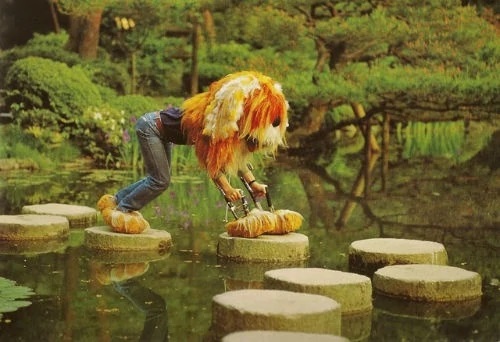
RBC: Right, and a lot of bounce in your step! I remember there was an episode where they celebrated Barkley’s 3rd birthday, and he was with Linda then. That was when they first told me his age, and I don’t think he’s aged since then.
Anyway, it was about a year after the audition when they called to give me the role. They sent it to everyone for approval – they sent it to LA, London, and New York. So eventually I got the call – and again I was out of town!
TP: Oh, wow.
RBC: Yeah, I’ve found the only way to get a job is to leave town.
TP: I guess that’s the recurring theme here! So they brought you in, and do you remember the first thing you taped for the show as Barkley?
RBC: Oh yeah! The first show when I arrived, the whole set was decorated with balloons, and there was this big buffet, and all sorts of excitement… but it wasn’t for me. It was Hillary Clinton.
TP: Wow!
RBC: Yeah, she was there that day. I was working with Jerry Nelson. He was Mumford, and Mumford had turned himself into a dog. Barkley desperately wanted to play with this dog. I was off-leash – they didn’t establish the “leash law” until a few years after that, so Barkley could be loose on the street and it was okay.
TP: I don’t think of Barkley as ever being on a leash, but I guess in the later years they put him on a leash?
RBC: They did. If I’m saying this correctly, they didn’t want kids to just go up to stray dogs. They were teaching etiquette with dogs, to show kids how to approach a dog and how to greet them and so on. One of the issues, which was going on in New York, was a leash law. They had to come up with a way to have Barkley on a leash.
There’s a harness that I have to get into underneath the fur, and then the leash clips through a hole in the back of the fur. Then there’s a harness that goes around the outside of the fur as well. It is a complicated thing, but they figured it out.
TP: Does that make it harder to move around, or is it essentially the same?
RBC: No, the tricky thing there is the person doing the walking. With most of them, it’s easy enough, because the straps go around my chest. It’s like a breathing thing. Am I pulling them down the street, or are they running with me? Most people run with me.
I’ve yanked Oscar out of his garbage can. He yanked my leash once, and for the whole episode he’s behind me going “Whoa-oh-oh-oh!” [laughs] Emilio [Delgado] was very strong; he was a good dog walker. Linda [Bove] was very good. She would just run along with me. But a lot of times it wasn’t so much walking him as seeing him on the leash. I’d come into a scene and then we’d exit, so it wasn’t like a scene of me constantly on the leash walking around.
But there is that song called “Walkin’ the Dog” where they filled up the street with real dogs and we went all over Sesame Street. I said, “Walking a dog is for… an obvious reason, so what are the rules here?” And they said, “You can sniff the fire hydrant, but don’t linger.”
TP: Right. That’s… yeah. Right.
RBC: Oh, and this is terrible. There was a French mastiff [in the scene], and I got that dog this job. I met this dog in the park. You remember Turner and Hooch, that movie?
TP: Yeah.
RBC: Picture the mouth on that dog. This was that kind of dog, and they were looking for all different sizes and shapes, and I had met this girl in the park and [connected her with the producers] and got them the job for the day. But I think Barkley looked like a chew toy to that dog.
TP: Uh-oh!
RBC: I was standing there in front of one of the windows on the street, and I looked to my left, and I saw the reflection of the mastiff, and the woman wasn’t looking at the mastiff. She was looking at something else that was going on. And the dog lunged with its mouth open for my rear end.
I didn’t have time to run or move; I just sort of swiveled myself forward, and the “SNAP!” of his jaws came just behind me. I pointed that out to the owner, and she went “Oh, sorry, sorry!” I think I must have looked like one of those big toys that they give to dogs, and he thought, That’s for me!
TP: Like a big, fuzzy squeak toy.
RBC: Yeah, I would have squeaked! [laughs]
TP: You’ve been talking about the way you see in the puppet. Is there a monitor in Barkley?
RBC: No. They talked about it, and the problem is, although he looks so big, there’s not a lot of space inside. They tried to figure out a monitor, and also at one point they tried to figure out a cooling vest, which was very nice, but there just wasn’t the room inside.
I see through the mouth, so my eyes are in that black area behind the tongue. The funny thing there is, you’ll get directors who forget I see through the mouth. I grabbed Baby Bear’s mobile at one point, and when I grab it, I’m blind. I have no vision of anything. I can’t even see the mobile. The mouth is just closed, and you hope you’ve got the mobile in your mouth because you can’t tell whether you’ve got it or not.
On this one day, the director said, “Run to camera one,” which is Frankie Biondo’s camera. I said, “Where’s that?” and they said, “Over here.” And I hear Frankie say, “Over here, ya animal!” But I can’t see!
The director says, “I’m waving my hand!” and I said, “When the mouth is closed, I can’t see!” and they said, “Oh!” So I said, “Listen, there’s a football helmet in here, so I’ll just run, and if someone could stop me before I hit the camera that’d be good!” [laughs]
But on the first day, when I was playing with Mumford the dog, they decided to put [Mumford] on a wall, which meant more exercise because I had to jump up to get to the dog. I was supposed to leap, and play, and bounce up and down, and be very excited. All the dog wriggling of “Hello, how are you? I want to play with you!” With the front paws slamming down, and leaping up to him, because he was above my head. Plus I was doing all the barking and panting, so I was really hyperventilating.
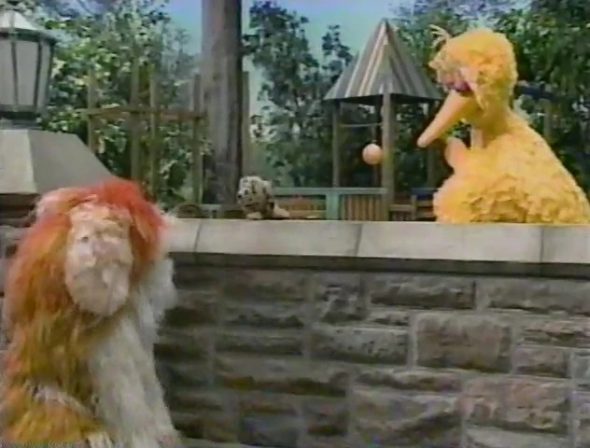
I think the director was Lisa [Simon], and she just assumed I knew what I was doing, and she just let me go on. As long as I hit my marks, there wasn’t much direction that I got. We did it again, and then we did it a third time, and I was really losing my air. Frankie came to me and said, “Listen, don’t do any panting. We’ll add that in later on if we need it.”
Frankie would always give me good notes like that if I needed it. He would say things like, “If you can manage to look over your right shoulder as you’re running, I can pick you up on camera one.” He gave very specific, helpful directions, which were great. I think by that time Barkley’d been on the show for so long that maybe some of the directors just assumed the guy inside knew what he was doing.
TP: But you were still new to it.
RBC: I was new. There was one day, I’m sitting in there and somebody’s waving a piece of cardboard in front of my mouth to cool me off between takes, and I hear, “Fred? Fred? …Fred! Can you hear me? Fred?” This just went on and on. It was [director] Emily Squires. I’m thinking, Why isn’t Fred answering? “Fred? Fred?”
And I hear somebody say, “That’s not Fred in there.” “Oh. Who is it?” “That’s Bruce.” “Oh. Bruce?” “Yes?” If you call me by the right name, I’ll respond! [laughs] That was funny.
TP: It’s funny that they didn’t all know it was you.
RBC: It was, but that first year I was only on thirteen shows, and I think they were doing 165. They would work for six months, and in that six months I was there thirteen days, and I’m sure there was a lot of other things they were dealing with or thinking about. Maybe it was Emily’s first time with me.
TP: What is the mechanism that makes Barkley’s mouth move?
RBC: I told you about the handle that you put your hands on, to extend about a foot above the ground. The right leg has a lever attached to it, and that closes the mouth. The movement of the head is from my own head. So if I’m panting, I’m bobbing my head up and down. That moves the lower jaw and the tongue, which is weighted. The mouth closes up with the lever.
Then the ears are activated by turning the head to one side or the other or straight back. That’s a wire that tightens, that’s attached down through the legs.
It takes a while to get in there. There’s my “onesie” that I’m wearing… and there’s scoops for my arms to go through, and between the fur and me, there’s another piece of material, of the suit. So you don’t want those wires to go down in the arm hole of the outer suit because then that keeps the ears pulled straight up. You have to make sure the wires go outside that, between the fur and that suit, and then the next layer is me. So… yeah. [laughs]
TP: That is very complicated.
RBC: It is, but they know what they’re doing!
TP: Yeah, and that just makes it that much more impressive that you make it look so easy.
RBC: Well, the nicest thing is to hear somebody say “You look like a real dog.” We had one episode – some of the Muppeteers were saying, “You might want to go and meet with the writers and suggest some things for storylines,” and I came up with maybe ten, twelve ideas.
One of the writers – who’s no longer with us, so I can tell you about this – took eight of the ideas and put them in one storyline! I thought, Oh, I can get twelve stories out of this! Twelve days of work! Nope, I got one. But I was very active! [Editor’s note: I believe it’s this episode.]
One of the things in that one was the idea of, what does Barkley understand, sign language-wise? We’ve established that he’s Linda’s pet, who is deaf.
TP: And that had happened before you came on, that he became Linda’s pet?
RBC: Yes. So I suggested using him more as a hearing dog: What is he like at home? Maybe he hears the tea kettle, or an alarm clock. We established that, with Barkley being able to wake Linda up when the alarm clock goes off. We’d established “sit, stay, run,” at that point, teaching the kids sign language. So I thought, if Linda signs “Go to the kitchen and get me a Kleenex,” Barkley might do it.
It was funny working with Linda with the sign language, because I couldn’t see it. I had to sort of feel when she was doing it. She never gave me difficult things. It was mainly “Sit. Stay. Down.” We just had to work out a way for me to know when the sign happened.
TP: That’s the kind of thing people watching at home never thinking about, the coordination that goes into something like that.
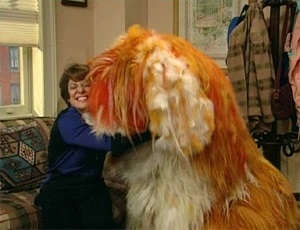
RBC: There was one time she had to accidentally break a vase. We were with Elmo, I think, and we were at Ruthie’s store, who ran the curiosity shop [Finders Keepers, on the “around the corner” set]. Linda was looking at this painted vase with flowers on it that she really liked. She didn’t know if she was going to get it or not, but she was thinking about it.
Then I charge off to chase a cat, and I’m on a leash, and she turns back to put the vase on the stand outside the store and runs after me, and the vase is supposed to fall and smash. Elmo’s wondering, “Why did Linda break the vase and run away?” Then Ruthie came out and saw the vase, and they realized, not only can Linda not speak, she can’t hear sounds.
The thing is, the vase wouldn’t break! We did that over and over and over, and every time… It bounced, it landed whole, it would not break. Finally, they took it to the shop and they drilled holes in the bottom to weaken it so it would smash when it hit the floor. Linda [Bove] wouldn’t know if we had done it right or not. She would just have to wait off camera for someone to say yes or no.
Ruth Buzzi, of course, I knew from Laugh-in. I did one show with her that was so great, because both of us had worked improvisationally. She was such a comedian, and the show really wasn’t structured for her to be a comedian. She mainly ran the curiosity shop and there wasn’t the chance for her to be funny.
But there was this one where the two of us just sort of went with it, it worked, and they took the scene in one take. Big Bird was demonstrating “light” and Ruthie was going to do “heavy.” Barkley is with Ruthie, and he’s gradually falling asleep while Big Bird is showing a feather, and [sing-song voice] throwing it up… and letting it drift down to the ground… and taking a ping-pong ball… and throwing it up… and letting it come down… He’s teaching us “light,” and then he says, “Okay, Ruthie. You show them ‘heavy.’”
She tries to get up, and Barkley has fallen asleep with his head on her lap. She tries to get up, but you know how some big dogs just really want to sit on your lap? She’s thrashing around, but I got myself right on her legs and just cuddled on her lap. And she slid off the bench she’s sitting on and went to the floor, and I just cuddled onto her. She’s flailing and going, “I can’t – he’s heavy!”
They took that in one take, and just kept filming. I thought that was great, that a) the director and cameramen and everyone just stayed with us, and that they allowed us to do that. They let us have fun.
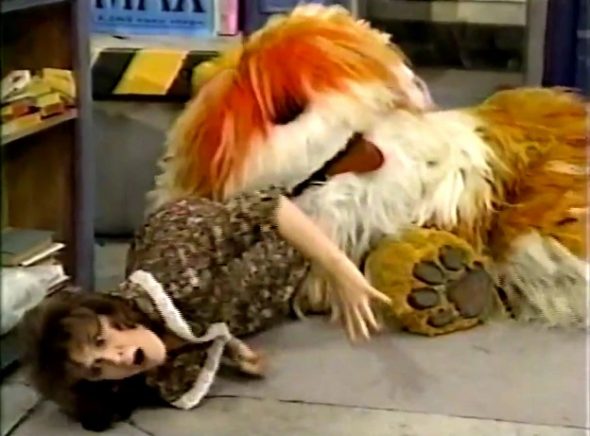
My first day, Frank Oz had a meeting with everybody, and I remember him saying, “The script is not the Bible. That’s your jumping-off place.” And I remember him telling me, “Your job is to make other Muppets laugh.” Isn’t that great? Can you imagine that as a job? Wow, that’s quite a – as they say in Shakespeare, you’re an “allowed fool.”
TP: That definitely seems to be the way Frank Oz approaches things!
RBC: Yep! And Frank Oz was Grover, so he was the one who hooked me with “Near and Far.”
This was really weird and funny, in this one episode. Try to follow this if you can: Telly had a disguise kit. He would do a silly hat and a moustache, and everyone would go, “Hi, Telly!” and he would get upset because they knew who he was, and he’d put on something else, and they knew who he was. He was getting very depressed, because everyone knew who he was when he was in disguise! How could they tell who he was?
So we’re all sitting on the step [of 123 Sesame Street], and I said, “I wonder if there’s space for me on that top step?” I practiced walking up and down those steps in my crutches, and I found I could do it. And on the [top] step there was plenty of room!
So I was sitting there, and there was Susan, and Linda next to me, and one of the little kids. Somebody on the street – maybe it was Gordon, says, “Listen: When Telly comes down the street, pretend you don’t know him.” Susan signs that to Linda and the kids… and then Linda turns to Barkley and signs, “When Telly comes down the street, pretend you don’t know him.”
I said, “Wait a minute! Are we saying that Barkley understands concepts now?!”
TP: That’s a pretty nuanced instruction to give to a dog!
RBC: Right! Emily said, “We’ve established he understands signs,” so I went, “Okay!” I watched the sign very closely, and when Linda signed, I went, “RUFF!” Like, “I got it!” So I didn’t recognize Telly when he came down the street!
TP: And that’s in the episode?
RBC: Yeah, that’s in the episode!
TP: He’s a very smart dog!
RBC: He’s a very smart dog!
Stay tuned for more great anecdotes from R. Bruce Connelly in part two! Click here to pretend you don’t know Telly on the Tough Pigs forum!
by Ryan Roe – Ryan@ToughPigs.com
